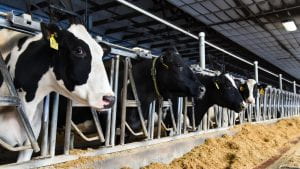Automated sensor technology for dairy cattle is not only a trending option for dairy farms, but one that is starting to look more attractive as the dairy industry continues to evolve. This article strives to bring some considerations to mind when thinking about adoption of this technology before any purchases are made. Considerations shared are from conversations with Dr. Julio Giordano of Cornell University, who is an excellent resource on all aspects of automated sensor technology for dairy cattle.
Sensors
There are several options for companies to work with, as well as types of sensors available. Typically, sensors are available to be placed in the ear as a tag, or on the collar worn by the cow. Each has their pros and cons, but thinking through which application is right for the herd and facilities is a good first step when considering adoption of a system. If the herd is considering moving towards robotic milking, setting up a collar system from the start may be the right move. If there are problems with using collars, but the herd has facilities that make applying ear tag sensors easy, it may be the better plan. With whichever application a farm chooses, know that there will be a learning curve for the application of sensors and how they may be lost or damaged.
Number of Sensors Needed
The more sensors you utilize, the more expensive (in general) a system will be. By not doing 100% of cows, a herd can save a significant amount of money if they choose to only utilize sensors on half or slightly more of their cows. This scenario makes sense if a herd will be utilizing them for reproduction only, but realize that the poorer reproductive performance a herd has, the more sensors a herd will need, as they would typically stay on cows longer than a herd with excellent reproductive performance. In general, if a herd wants to improve reproductive performance, sensors will achieve about the same results as good visual observation two times a day for about a half-hour each time.
If a herd wants to utilize sensor technology for both reproduction and health, a herd can still plan for sensors for a percent of cows, but this may be closer to 65-70% of the herd.
Integration with Dairy Comp
Be advised that all systems that are available don’t necessarily integrate well or at all with Dairy Comp 305. Many companies are working on software to achieve this, but if it’s a necessity for a herd to have their information integrated into their herd software, be informed of the choices available. For many herds, this isn’t a deal-breaker, and opt to flip between programs or utilize a separate monitor for sensor information when using it to compare to herd information.
Labor Savings & Investment
It is very important to keep in mind that a system won’t necessarily save a herd labor. Like many technologies, it does change labor and make timing more flexible – such as receiving an alert for a cow in heat, rather than watching for heats. Some herds have been able to minimize their reproductive programs – utilizing only an Ovsynch program instead of an Ovsynch/Resynch program, which has minimized reproductive drug costs and labor associated with giving those shots. At any rate, though, a herd does have to factor in time and labor for applying the sensors and upkeep of the sensors, as well as time to learn and properly utilize the system.
Questions to Ask to Help you Decide on a System
What’s the ease of applying the tag or collar, and where would do accomplish this? If there are no headlocks, would you utilize the parlor, and what impacts does that have?
What will the sensors get stuck on or hit on and damaged, or lost?
What’s the life span of the tags? What happens after that has expired?
What’s the company’s tag loss rate? Ask about a clause in your contract that states how many they’ll replace at no charge in a specified time period.
If you graze – what is the company’s calibration for grazing cattle? Have they calibrated sensors for grazing herds?
What are the best settings for your herd, and how much support is there for tweaking specificity and sensitivity?
What are their tech services? Who does the updates, and how frequently are they done?

